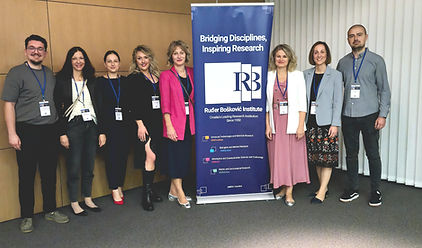

RadMagnNanoHyperT

Radiolytically synthesized magnetic nanoparticles for hyperthermia effect on cancer cells -RadMagnNanoHyperT
About the project
This Croatian Science Foundation project (IP-2022-10-3687) focuses on the development of a gamma-irradiation method for the synthesis of magnetic nanoparticles, and the application of synthesized nanoparticles for hyperthermia treatment of cancer cells. Radiolytic synthesis (gamma irradiation synthesis) is a relatively new method for nanoparticle synthesis. It is fast, efficient, ensures homogeneous and almost instantaneous reduction throughout the system, while not requiring the use of toxic/carcinogenic reducing agents, which makes it environmentally friendly method and gives her great advantages over classical methods of nanoparticle synthesis. By controlling irradiation parameters it allows good control of nanoparticle size, shape and phase composition.
In this project the anisotropic magnetic nanoparticles of iron oxides and ferrites will be synthesized by γ-irradiation in the presence of suitable polymers. These nanoparticles exhibit high crystalline anisotropy and excellent magnetic properties and are nontoxic, making them suitable for magnetic hyperthermia treatment. Magnetic and Mössbauer measurements will be performed to investigate the ferrimagnetic and/or superparamagnetic nature of the synthesized magnetic nanoparticles. These radiolytically synthesized magnetic nanoparticles will be applied to kill cancer cells in the presence of an alternating magnetic field (AMF) by releasing heat, resulting in temperature rise i.e., magnetic hyperthermia effect. It is expected that the synthesized disc-shaped magnetic nanoparticles will have a much higher SAR (high specific absorption rate) than corresponding spherical magnetic nanoparticles. The magnetic heating efficiency of the samples will be analyzed to evaluate their potential for magnetic hyperthermia application.
These measurements will be performed using a commercial magnetic heating device to be purchased with funding from this project. The synthesized nanoparticles will be applied to cancer cells and their subcellular accumulation and the effect of magnetic hyperthermia on killing the cancer cells will be measured. The cytotoxicity of nanoparticles will also be determined. Magnetic hyperthermia is thought to generate reactive oxygen species, leading to cancer cell death. We will specifically focus on elucidating the molecular mechanism of cell death and on the possible activation of the transcription factor NRF2.
Project facts
In this paragraph you can include any content you would like to share with the user. Just click "Edit Text" or double click to add your own text and make changes to the font.



